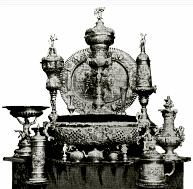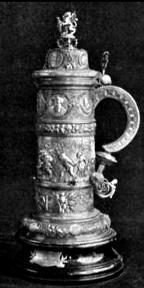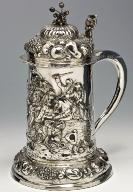Online Encyclopedia of Silver Marks, Hallmarks & Makers' Marks
| |||||||
|
by Jörg Müller-Daehn Hanau companies have caused a lot of confusion amongst collectors, art historians and dealers of silverware. What follows is meant to shed some light on the history of this segment of Hanau production and to provide some information on how to tell Hanau reproductions from genuine antique pieces. I. History of the Hanau silverware industry
II. J. D. Schleissner goes to town Johann Daniel Christian Schleissner (b. 1793 - d. 1862) came from an old Augsburg family of goldsmiths and moved to Hanau in 1816 or 1817. He produced pieces in the Augsburg style, was quite successful and exported a lot of his wares to Russia, France, Austria, the Near East etc. His success brought other makers to
The industrial revolution had brought wealth to many people worldwide, Germany had acquired additional wealth from France, which had to pay huge sums as a result of her defeat against Germany in the war of 1870-71. People everywhere wanted to show their wealth, building lavish homes and filling them with expensive, heavily decorated objects; furniture, carpets, all kind of antiques, among them silver objects. Schleissner realized that not enough genuine old objects were on the market.
III. How not to be fooled by pseudo marks Can pieces in the antique style, marked with pseudo marks, be considered forgeries? That is a matter of discussion. Hanau makers never claimed to produce "genuine old objects", they mostly referred to them as copies "in the antique style" ("im antiken Genre"). But Hanau makers cared little about what the many antique dealers, selling those objects, said about these objects. It was an open secret that many of those dealers falsely claimed pieces to be really old, thus fooling their clients. Another point: quite a few of the Hanau objects were made without any marks at all and were sold to retailers, antique dealers etc. in this condition. Who could know (or care) what kind of marks the dealers would finally stamp on the pieces?
Silver in the antique style was and is also produced in the Netherlands and Italy and other countries. The Dutch pieces may have correct Dutch marks or forged old Dutch marks (the latter which often can be identified by consulting the book by Citroen listed below). The Italian pieces usually have correct Italian marks. If trying to identify a Hanau piece one should try to find a match with marks as shown on this website or with marks as published in the books mentioned below. A good many pieces can thus be identified. Experience has shown that genuine old pieces are quite rare and that pieces in the antique style, even if the maker cannot be identified, usually date from ca. 1870 onwards to well into the 20th century. Sometimes one can find an importer's mark added to the pseudo marks, which may help with the dating.
IV. One last thing Hanau pieces in the antique style, even if the fineness is not stated, were and are usually made with a fineness ranging from ca. 12 Lot (before 1888, equals 750/1000 parts fine) upwards to 835/1000. Sterling is rarely used, usually only on pieces made for export to Britain and the United States. When testing the metal with acid (chromic acid), please note that this test is considered unreliable. It is not meant to indicate the fineness nor to tell silver from silverplate. Originally is was meant to tell silver AND silverplate from other
|
|---|
Suggested reading:1910: anonymous "Das antike Genre", article in "Deutsche Goldschmiede-Zeitung" (one of just a very few articles published on Hanau production in the antique style, with information on its development from many industry insiders. No illustrations) |
| Legal disclaimer: Text and pictures in this article are meant to be a first introduction into the subject of Hanau silver in the antique style and its marks. In no way is this article meant to give a thorough and / or flawless study on said subject. No responsibility whatsoever is taken for actions undertaken by anyone using the informations contained here. |









